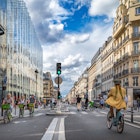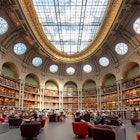
Sep 3, 2025 • 15 min read
While it’s hard for anyone to leave Paris, these day trips offer bucolic nature, gorgeous cathedrals and more – all only an hour or so away.

Sep 3, 2025 • 15 min read
While it’s hard for anyone to leave Paris, these day trips offer bucolic nature, gorgeous cathedrals and more – all only an hour or so away.

Aug 27, 2025 • 11 min read
Pick the perfect place to stay in Paris, with top choices in 10 of the best parts of the city.

Aug 21, 2025 • 5 min read
Experience the golden age of glamor with this luxurious art deco tour of Paris, from iconic architecture to curated hotel stays and private shopping.

Aug 5, 2025 • 6 min read
You can certainly enjoy walking around Paris, and here's info on the bus, metro, RER and more if you're traveling larger distances.

Aug 5, 2025 • 10 min read
With savvy planning and a bit of local know-how, you'll find a wealth of ways to enjoy Paris without blowing your budget. Here are our top tips.

Jul 31, 2025 • 8 min read
From drinking and dining to shopping and sleeping, explore the best of Paris’ 9th city district with this neighborhood guide.

Jul 7, 2025 • 7 min read
From a paddle in the Seine's new bathing zones to a dip in a beautiful public pool, beat the summer heat in Paris with this swimming guide.

Jun 29, 2025 • 11 min read
Eating a fresh-from-the-bakery croissant – while in Paris – is the perfect sensory memory to mark your trip.

Jun 24, 2025 • 7 min read
Bike through Paris and beyond with our pick of France's best cycling routes that start from Notre Dame.

Jun 23, 2025 • 8 min read
One of the biggest decisions a Paris-bound visitor faces, at some point in their trip planning, is which side of the Seine to stay in? We help you choose.

Jun 9, 2025 • 8 min read
With an estimated 27,000 visitors per day, it pays to get prepared before you arrive at Versailles. Here's a guide to making the most of your visit.

Jun 6, 2025 • 8 min read
Showcasing iconic masterpieces among art nouveau architectural majesty, the Musée d’Orsay is one of Paris’ top sights. Here’s how to best enjoy it.

Jun 6, 2025 • 6 min read
A comprehensive guide to visiting Paris’s largest cemetery, Cimetière du Père Lachaise, famous as the resting place of many celebrated Paris residents.

Jun 6, 2025 • 7 min read
The Louvre in Paris is one of the world’s most visited museums, but it can be intimidating to first-time visitors. Plan your visit with this simple guide.

Jun 5, 2025 • 9 min read
Piercing the city skyline, Paris' iconic Eiffel Tower beckons. Here's all you need to know to get more from your visit, including how to avoid the queues.

Jun 3, 2025 • 8 min read
Three decades since it first launched, the Eurostar remains a hit. Our thorough guide lays out everything you need to know about the Eurostar.

May 22, 2025 • 4 min read
You’ve surely heard of the Moulin Rouge – yet the Crazy Horse might be Paris’ most sophisticated cabaret.

May 13, 2025 • 4 min read
Packing for a trip to France this summer means stylish outfits, comfy shoes, being sun-smart, and downloading these apps. Bon voyage!

Apr 24, 2025 • 8 min read
Whether you’re browsing or buying, looking for the latest fashions or small souvenirs, follow these tips for a seamless shopping experience in Paris.

Apr 16, 2025 • 6 min read
If you’re traveling to Paris with babies, toddlers, tweens or (heaven help you) teens, here’s a full guide to keep everyone stimulated and delighted.

Apr 12, 2025 • 11 min read
Beyond the French capital's most famous sights, abundant free activities give off the same glittering magic.

Mar 27, 2025 • 9 min read
If you want to endear yourself to the Parisians, there are certain codes of conduct you should know.